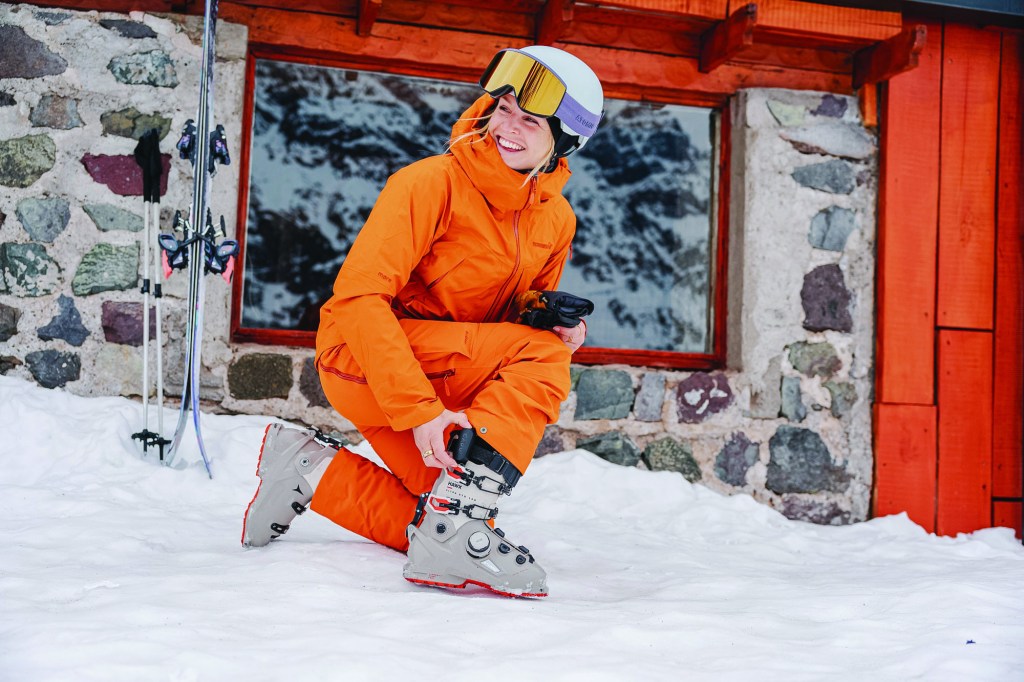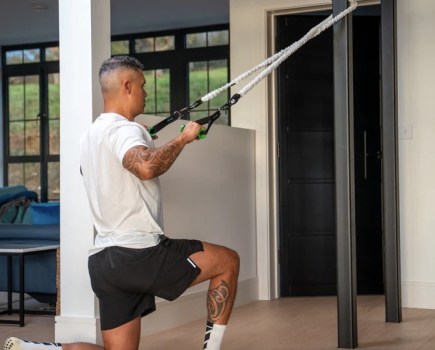Want to improve your skiing? CARV 2’s clever tech will help
Men’s Fitness verdict
Carv 2 is simple, quick and easy-to-use. Pair it with your phone and you’re off. Data delivery is seriously impressive and the real-time feedback means you can make near-instant changes to your skiing- real-time coaching in your ear
- quick, simple and easy to use
- instant feedback on ski performance
- more metrics than you’ll ever need
- total beginners might still need help
- total beginners might still need help

I’m not exactly Alberta ‘La Bomba’ Tomba – the Italian who won three Olympic Gold medals – when it comes to skiing. In fact, I’m not even Eddie the Eagle (cheap joke – contrary to popular belief, Michael Edwards was a very decent skier indeed).
I didn’t put skis on until I was 51, by which tender age I already had a metal pin in my foot. This, coupled with an innate lack of co-ordination, makes me an enthusiastic but completely skill-less skier. In other words, when it comes to skiing, I need all the help I can get.
Fortunately, British wearable technology company, Carv, might just have the answer. The company had invited me out to Innsbruck, hosts of the 1976 Winter Olympics, and a mecca for skiers all over the world. What was I doing there? Ostensibly, to test the company’s new Carv 2 digital ski coach; in reality, I was just trying not to break a limb.
Carv 2 is an ingenious system that wirelessly links a motion sensor clipped to each ski boot to a mobile phone app and headphones. Using gyroscopes, accelerometers and some very advanced AI, it analyses the angle and movements of your skis, as well as the snow type, before offering verbal coaching advice through your headphones of choice as you hurtle – sorry, descend gracefully – down the mountain.
The whole system was developed by British duo Jamie Grant and Pruthvikar Reddy, with the help of professional ski coaches. Unlike previous generations of Carv, which required installation into the boot (using an intelligent insole) and were primarily tuned for on-piste analysis, Carv 2 brings the magic of real-time coaching to every skier.
“Carv 2 changes everything,” says Jamie, CEO of Carv. “We’ve listened to our community and developed a solution that offers the flexibility, and ease of use skiers have been asking for, combined with an increase in accuracy that makes it our most powerful product to-date.”
“We built Carv 2 for every skier, regardless of their gear or terrain. Whether you’re blasting through powder, navigating your first bumps, or carving down the piste, Carv 2 is your constant companion, analysing every move and providing real-time feedback to help you improve with every turn.”
So, with my Carv2 devices clipped to my boots, it was time to give the system a whirl. If you’re a seasoned skier, I’m guessing that hitting the slopes for the first time after a few months away, is much like riding a bike. The muscle memory is still there – and you just glide down the slope. If you’ve only ever skied once, then just the feeling of standing on snow with what seem like enormous flippers on your feet, is totally alien.

Thankfully, my guide, coach and personal support crew, Laura from Carv, was there to hold my hand, sometimes almost literally. I started with a couple of smaller runs, just to find my ski legs. Thankfully, I managed to maintain my dignity, didn’t fall over and made it the 400 metres or so to the chair-lift point. But, to give you a what Carv 2 calls your “Ski:IQ” you need to complete eight turns, which of course means you need a decent enough distance to make the turns in the first place.
So, next up was a longer run down to the first cable car. I felt reassured that Laura was never too far away from me, but thankfully made it down the blue slope to the stop-point without falling over – I even got my first Ski:IQ score (89) which, according to the Carv2 progress system made me a ‘Green Guru’, a polite way of saying total novice! An average skier has a Ski:IQ of 100. As your ability increases, so too does your Ski:IQ. Your Ski:IQ is just a nice grading touch: the system is seriously clever. What Garmin does for running in terms of metrics measurement, Carv does for skiing – with the added bonus of real-time feedback in your ear while you’ve stopped.
The system measures ‘global’ metrics such as the number of turns made, your top speed, average speed, total distance skied and maximum altitude. But it’s the ‘sub-metrics’ which are fascinating and where individuals who really want to progress their skiing can get to the nitty gritty of their technique.
You get detailed breakdowns of each metric by clicking on the metric name. Just click on one of your segments, pick Rotary, Edging, or Balance, then the metric you want to take a look at. The metric detail screens will take you through why that metric is important, how to improve in that area, and your progress over time.
Scrolling through the graphs on the way back up the mountain, I could see that each of my turns had its own individual score. Even for someone with little knowledge of skiing, it was blindingly obvious that my right turns are better than my left turns (that would make sense as I’m right-dominant). It also showed me how much time I’d spent in snowplough on the turns and how much time in parallel (I didn’t hit the carving zone. Next time).
With renewed enthusiasm, a frisson of competitiveness and a dollop of chutzpah, it was back down the mountain. A voice in my headphones encouraged me to carve out my turns more aggressively by lifting my edges, keeping my skis parallel, and leaning my upper body away from the turn. It was tough going and my concentration levels were through the roof, but (despite one small fall) I again made it to the mountain’s mid-point, feeling as if I’d done better. And so the it proved: my Ski:IQ had gone up to 93 and I was now, according to Carv, a ‘Smooth Operator’.

Now, having warmed up my ski legs and improved my turn technique, thanks in no small part to the coaching advice from my Carv 2 device, I was ready to up my score again. Except that I had developed on overwhelming queasiness in the cable car back up and was starting to feel really not that great. I asked Laura if we could have a small break – I wanted to put the rising nausea behind me and give my Ski:IQ another boost.
To cut a long story short (and to avoid both my embarrassment and any sordid details), I’d developed altitude sickness. I’m not sure why but it sapped all my energy, focus and balance: I tried one more run, but fell over and just couldn’t get back up. That would be my skiing day over – and my Ski:IQ would have to stay at 93 for now.
In my short time with Carv 2, I learned so much – much more than I had when attending ski school on my only other time skiing. It’s like having a personal coach with you – which is exactly the point the founders were trying to realise. With more practice – and less nausea – I’m sure I could use the technology to hone my ski skills and progress up the rankings. Hey, maybe I’ll even get to speeds quicker than I can run at! If I can just conquer my altitude sickness…






